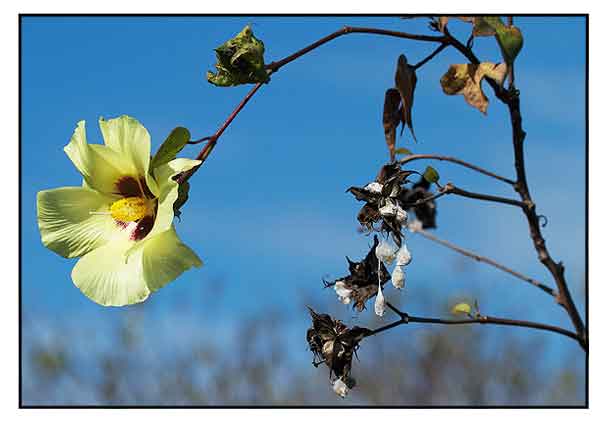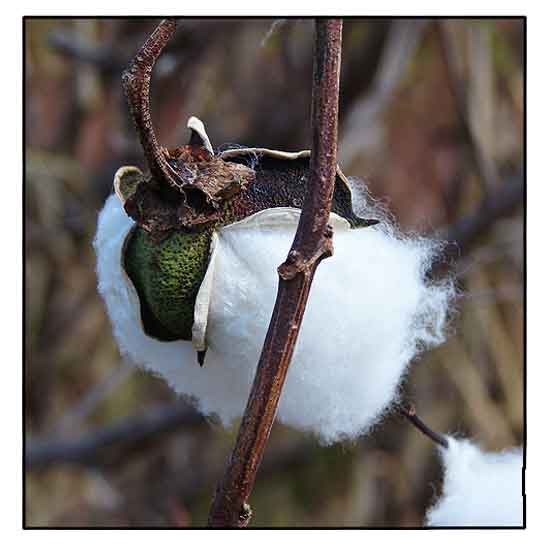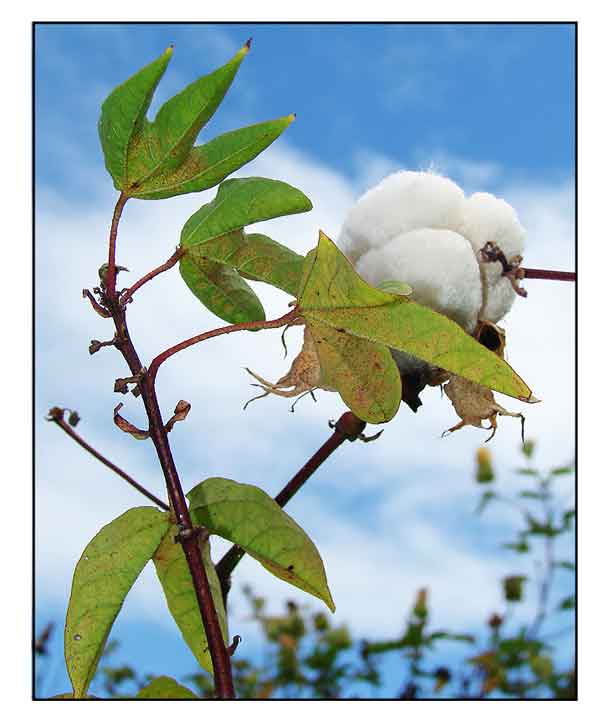 Gen info Gen info
- Gossypium comprises 40-50 species distributed in warm temperate to tropical zones. The four cultivated cottons of the world -- the Old World diploid "desi-cottons" G. arboreum and G. herbaceum and the New World tetraploids G. barbadense and G. hirsutum -- have been domesticated in different parts of the world.
- Cotton has been cultivated for thousands of years on different continents. The oldest evidence of use of cotton, probably G. arboreum, as fiber plant is estimated to date back from 2300 BC.
- It is the most important fiber in the world used for making yarn woven into textile fabrics, sewing thread, cordage, or fishing nets, paper, twine, upholstery, explosives, plastics, and photographic film.
(1)
- Etymology: The genus name Gossypium derives from the Arabic word goz, which refers to a soft substance. The specific epithet barbadense refers to "cotton encountered in Barbados". (2)
- G. barbadense cotton accounts for about 5% of the world's cotton production.
Botany
Gossypium barbadense is a perennial shrub, usually cultivated as an annual subshrub, 1-1.5 (-3) m high. Tap root robust, often with four rows of lateral roots. Main stem monopodial with internodes decreasing in length from the base to the top; nodes bearing leaves with axillary branches. Leaves spirally arranged, long-petiolate; lamina usually 3-5-lobed, 7.5-15 x 7.5-15 cm, cordate at base and with triangular and acuminate lobes, usually with stellate hairs and glands on undersurface of main veins; stipules present but caducous, falcate, ca 10 x 4 mm. Flowers solitary on axillary, sympodial branches, seemingly opposite the leaves, stalked with three glands near the top of the pedicel; epicalyx consisting of 3 (-4) large toothed segments; calyx small, cup-shaped, obscurely lobed; petals 5, obovate, ca 5 cm long, initially creamy-white and turning pink or red; stamens numerous, filaments united in a staminal column; ovary superior, style inside staminal tube, stigma lobed. Fruit a leathery, spherical or ovoid capsule, 2-6 cm long, (3-) 4-5-locular with numerous seeds. Seeds pear-shaped, 3.5-5 mm long; testa with short and very long, convoluted hairs. (14)
Distribution
- Introduced.
 Constituents Constituents
- GC and GC/MS study of cotton leaf for essential oil revealed 19 compounds accounting for 92.6% of total oil fraction. Major constituents were monoterpenes comprising of tricyclene (29.6%), bornyl acetate (18.6%), α-pinene (12.8%), α-terpinene (11.1%), isoledene (6.0%) and ß-pinene (5.4%). (see study below) (7)
- Study of ethanolic extracts of leaves and roots yielded alkaloids, tannins, saponins, flavonoids, glycosides, phytosterols, carbohydrates, proteins, and anthraquinones; terpenoids were absent in the leaves while glycosides were absent in the roots.
- GC-MS analysis of seeds 9,12,15-octadecatrienoic acid, (Z,Z,Z)- with highest peak area percent (70.10%),
followed by linoleic acid ethyl ester, 12=methyl-E,E-2,13-octadecadien-1-ol. Fatty acid analysis yielded 9,12-Octadecadienoic acid (Z,Z)-, Hexadecanoic acid methyl ester, 9,12-Octadecadienoic acid (Z,Z)- methyl ester was found to be high. (19)
- Hydrodistillation and GC-MS study identified 13 constituents accounting for 100% of total oil, which yielded significant amount of ß-caryophyllene (40.97%), α-pinene (15.9%), α-caryophyllene (12.15%), and α-copaene (8.48%). (see study below) (21)
- Phytochemical and mineral analysis of methanolic extract of leaves yielded the presence of alkaloid (3.82 ± 0.17), flavonoid (2.80 ± 0.18), total phenols (5.94 ± 0.41), cyanogenic glycosides (18.07 ± 0 .54) and saponins (7.28 ± 0.19) in mg/100g. Anthraquinones and terpenoids were absent. Mineral analysis element yielded iron (544.81 ± 0.0024), magnesium (447.05 ± 0.0051), zinc (13.56 ± 0.0011), calcium (17.76 ± 0.001) and potassium (3.321 ± 0.0027).
(24)
Properties
- Studies have suggested hypotensive, antibacterial, wound healing, hematinic, antimalarial, antiulcer, biomembrane stabilization, cytotoxic, mutagenic, antifertility properties.
Parts used
Leaves, aerial parts.
 Uses Uses
Folkloric
- In the Philippines, decoction of Gossypium leaves used for treatment of diarrhea and mild dysentery. In Indo-China, entire plants use for fever; decotion taken against malaria; infusion of flowers and leaves used as pectoral; concentrated maceration used against inflammation; roots are astringent, antidysenteric, diuretic and emollient, and used in fumigations against hemorrhoids. (1)
- In Suriname traditional medicine, used for treatment of hypertension. Decoction of leaves drunk to regulate menstruation and treat uterine problems.
- Leaves used for wound healing.
- Used for ear pain, dysentery, abdominal cramps, and postpartum care. (Luziatelli et al., 2010).
- In Brazilian traditional medicine, leaves are used as uterotonic, menstrual regulator, anti-hemorrhagic, uterine anti-inflammatory and used for fever, earaches, strokes, and body pains. (11)
- In Nigeria, leaf decoction given to babies, a teaspoon three times daily, for treatment of neonatal jaundice. Leaves used for treatment of viral hepatitis.
- In the Guianas, leaves used to treat hypertension and pain; macerated leaves to control itching. Also used for pain and stress to treat Dominican short or chronic "fright" illnesses. (17)
- Decoction of bark of cotton roots was an official U.S. drug from 1863-1950 to stimulate menstrual flow and aid contractions during labor. Northern Peruvians use it topically for wounds; Jamaicans, for hemorrhoids. Yucatans use flower bud juice for earaches. Venezuelans, Trinidadians, Jamaicans, and St. Kitts people drink infusions of leaves and flowers for bronchial and pulmonary problems, colds, and flu. Cubans drink decoction of seeds for bronchial problems. Ancient Mayans used roots for asthma. (17)
Others
- xxx: Used as com
 Studies Studies
• Hypotensive / Leaves: Study evaluated the antihypertensive effect of decoction of leaves. Fraction II (frII) of the crude extract of G. barbadense showed a dose-dependent effect in anesthetized rats. Acetylcholine receptors could be involved in the mechanism of action of frII. Although the active substance(s) is(are) not known, the results may explain its traditional use as medicine in Suriname. (4)
• Antibacterial / Wound Healing / Leaves: Study evaluated the antibacterial and wound healing properties of methanolic extract of dried fresh leaves of G. barbadense. The antibacterial properties were studied against five wound isolates viz., Pseudomonas aeruginosa, Staphylococcus aureus, Escherichia coli, Proteus mirabilis, and Shigella sonnei using Well diffusion method. Results showed dose-dependent activity against all test organisms except E. coli. In wound healing study using excision model on healthy albino rats, the extract applied at 20 mg/ml showed 91% wound healing compared to Cicatrin® powder at 80% and distilled water at 36%. (5)
• Biomembrane Stabilization / Antiulcerogenic / Leaves: Study evaluated the membrane stabilization and detoxification potential of aqueous leaf extract of G. barbadense in indomethacin-induced oxidative gastric ulceration in Wistar rats. Indomethacin-mediated significant elevations in ulcer index, gastric volume, pepsin activity, and mucosal level of malondialdehyde were dose-dependently attenuated in the extract treated rats. The extract also modulated and improved pH, mucin content, glutathione (reduced) as well as gastric activities of SOD and catalase in the ulcerated rats. Improvements were attributed to antioxidant and membrane stabilizaton effects of the extract from the active metabolites. Effects were comparable to omeprazole. Results suggest the leaf extract can prevent indomethacin-mediated gastric ulceration via fortification of antioxidant defense mechanisms. (6)
• Antimicrobial / Leaf Essential Oil: GC and GC/MS study of leaves for essential oil yielded 19 components. The oil consists of 12 monoterpene hydrocarbons (66.1%), 1 oxygenated monoterpenoid (18.6%), 4 sesquiterpene hydrocarbons (7.4%) and 1 aliphatic aldehyde (0.5%). The oil displayed moderate antimicrobial potential against S. aureus, Gardinella spp, E. coli and C. albicans. (see constituents above) (7)
• Antimalarial Study / No Significant Effect / Leaves: Study evaluated the antimalarial effect of aqueous leaf extract of G. barbadense using mice infected with P. berghei. Results showed the aqueous leaf extract when used alone has a non-significant (p≥0.05) but slight suppressive antimalarial activity (23%) when compared to chloroquine (100%). The curative model also showed no significant antimalarial activity. Results conclude that the aqueous leaf extract has no significant therapeutic effect as monotherapy. (8)
• Hematinic Potential / Leaves: Study evaluated the hematinic potential of leaves in albino rats with hemolytic anemia induced by phenylhydrazine. Bioferon was used as standard drug. Treatment with G. barbadense extract resulted in dose dependent increase in hemoglobin, RBC, and PVC. The ip LD50 was calculated to be 2154.07 mg/kbw. (9)
• Antibacterial / Cotton Fibers Containing Ampicillin: Study evaluated the antibacterial activity of cellulose cotton fibers containing ampicillin moieties. Ampicillin, a large spectrum antibiotic, was covalently coupled to cellulose backbone of hydrophilic cotton fibers by heterogenous synthesis to produced a functionalized biopolymer. Antibacterial activity was evaluated by microorganism inhibition in Petri dishes. Results showed the biomaterial possess excellent "in vitro" antibacterial activity and has potential for chronic wound management. (10)
• Cytotoxicity in Bone Cord Cells / Mutagenicity: Study evaluated the mutagenic or antimutagenic activity of ethanolic extract of G. barbadense and its capacity to prevent or repair mutagenic lesions caused by cyclophosphamide (CP) in Swiss mice. Results showed the extract caused a significant increase in the number of micronucleated erythrocytes, indicating mutagenic activity of the extract The extract did not have to capacity to prevent but showed capacity to repair chromosomal damages caused by CP. (11)
• Antibacterial Against Salmonella Isolates / Leaves: Study evaluated the antimicrobial potential of leaf extracts of G. barbadense against Salmonella typhi isolates. Extracts were prepared using three different aqueous extraction solvents (7up, distilled water, and ethanol). G. barbadense showed innate anti-Salmonella properties. The distilled water seemed the better vehicle for extraction. (12)
• Gossypol / Induction of Hairy Root Cultures: Hairy root cultures were induced by inoculating cotyledonary leaves and hypocotyl segments from two cotton species, Gossypium hirsutum and G. barbadense, with Rhizobiu rhizogenes 15834. After 3 weeks in liquid culture, both cotton species produced gossypol, a di-sesquiterpene secondary metabolite with known anticancer activity, and two related methylated derivatives. Average gossypol level obtained among 96 cultures was 15 mg/g dry culture mass, with some cultures yielded >40 mg/g dry culture mass. The high level of gossypol production suggests they will be valuable for a study of biochemical and molecular aspects of gossypol biosynthesis and understanding of bioactivity mechanisms. (13)
• Antimitotic / Gossypol and Gossypolone / Root Bark: Study of root bark of G. barbadense var, Giza isolated gossypol (8,8'-dicarboxaldehyde, 1,1',6,6',7,7'- hexahydroxy, 5,5'-diisopropyl, 3,3'-dimethyl, 2,2'- binaphthalene). The antimitotic activity on Allium cepa L. root tips was investigated. The mitotic rate was markedly decreased after 3, 6, and 24 hr incubation with 500, 250, and 125 ppm of gossypol, and with gossypolone, decrease in mitotic rate was noticed after 6, 12, and 24 hr. Both gossypol and gossypolone markedly decreased growth rate of Allium cepa bulbs in a dose-dependent manner. The assay is an easy and inexpensive method to evaluate the agents with antimitotic potential useful for treatment of cancer. (16)
• Antifertility / Seeds: Study of evaluated the effects of chloroform extracts of seeds of Sea Island cotton, Gossypium barbadense; ethanolic extract of seeds of soybean, Glycine max; and ethanolic extract of leaves of rosemary, Rosmarinus officinalis, on fertility of male albino mice. Oral administration of all extracts caused a significant reduction in sperm count and motility, with severe histopathological effects on the testes. There was also a significant decrease in concentration of free testosterone, increase in activities of ALT and AST. Results showed the extracts have antifertility effects and may be used for control of house mice. (18)
• Selenium Nanoparticles / Cytotoxic / Anticancer / Leaves: Study reports on the green, rapid biosynthesis of selenium nanoparticles (SeNPs) using G. barbadense leaves. Anticancer efficacy was assessed against colorectal carcinoma (HCT116) and human pancreatic epitheloid carcinoma (PANC1) using MTT assay. The SeNPs showed potent cytotoxic activity with HCT116 shoeing more sensitivity than PANC1. (20)
• Cytotoxicity / Volatile Oils / Fruits: Study evaluated the cytotoxic effects of G. barbadense fruit oil on human cervix adenocarcinoma (HeLa) and mouse fibroblast (3T3) using MTT assay. The oil exhibited notable cytotoxic activity against HeLa and 3T3 cells lines with IC50s of 47.0 and 59.5 µg/mL, respectively. (see constituents above) (21)
• Toxicity of Seed Extract: Twenty adult male rats were injected intraperitoneally with 0.1 ml of aqueous cotton seed extract (Gossypium barbadense) in concentrations of 105.25, 21.21, 4.65, and 2.325 mg ml (kbw), respectively. Results suggest aqueous extract of cotton seed meal contains substances that can rapidly cause damage to testicular, liver, kidney and muscular tissues. (22)
• Antihypertensive / Leaves: Study evaluated 8 Surinamese medicinal plants for potential to reduce increased peripheral vascular resistance associated with arterial hypertension. The plants were evaluated for ability to relax isolated guinea pig aorta rings pre-constricted with phenylephrine. G. barbadense leaves was one of four that decreased the tension of phenylephrine-stimulated aorta rings by 15-35%, suggesting the extracts may lower elevated blood pressure by decreasing peripheral vascular resistance. (23)
Availability
Wild-crafted.
Cultivated.
|

![]()





 Uses
Uses
